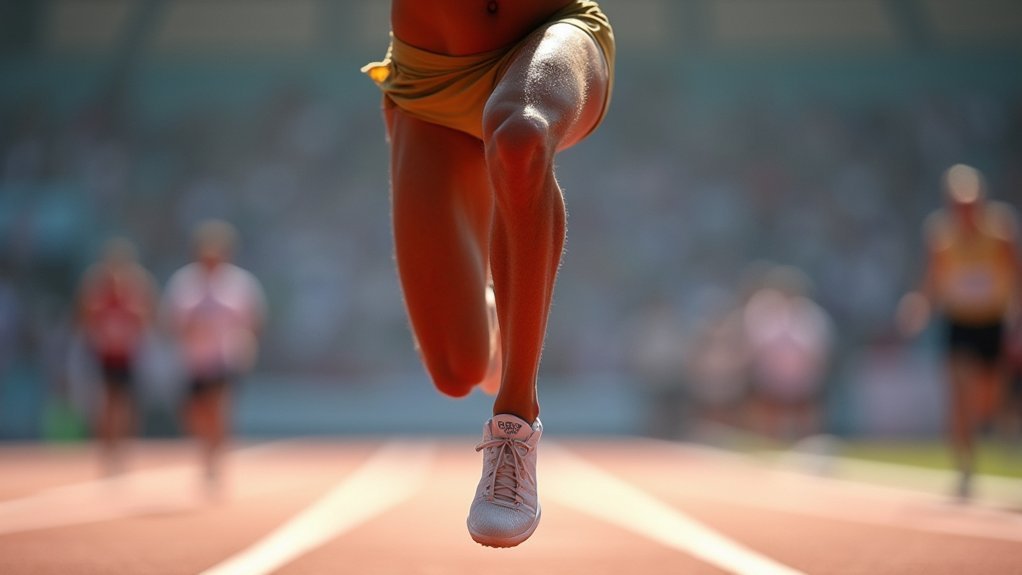Jump training activates your transverse abdominis (TrA) through anticipatory stabilization – your TrA fires 50-100ms before ground contact to protect your spine. During landing, muscle spindles detect rapid loading, triggering automatic core engagement. Unlike traditional floor exercises, jumps require three-dimensional stabilization with reflexive TrA recruitment for both takeoff and landing phases. This natural activation pattern creates more functional core strength than isolated exercises. Discover how this powerful neuromuscular connection can transform your performance.
The Biomechanics of TrA Engagement During Jump Training

The sequential activation of core muscles during jumping reveals a sophisticated neuromuscular strategy where the transversus abdominis (TrA) takes center stage. Your TrA activates first—0.13 seconds before rectus abdominis and 0.02 seconds before external obliques—creating a stabilized foundation before movement begins.
This deep-to-superficial activation pattern isn’t random. Your TrA contracts anticipatorily, generating intra-abdominal pressure that transforms your trunk into a rigid cylinder. This finding aligns with research categorizing trunk muscles into local and global systems.
During push-off, when forces peak, your TrA works with the multifidus to maintain neutral spine positioning while counteracting reactive flexion forces.
The biomechanical brilliance lies in how your TrA simultaneously resists pelvic rotation and facilitates force transfer from lower to upper body, eliminating energy leakage and enhancing jumping performance.
How Landing Forces Stimulate Deep Core Activation
When your feet approach the ground during a jump, your body’s impact reflex mechanisms automatically engage your transverse abdominis before contact.
You’ll notice this pre-landing bracing occurs unconsciously as your nervous system anticipates the need for core stability to absorb landing forces.
This protective mechanism strengthens with practice, allowing you to develop more efficient bracing patterns that better protect your spine and enhance performance.
Drawing your belly button toward the spine during jumps enhances the deep core activation similar to proper pelvic tilt technique in Pilates.
Impact Reflex Mechanisms
Landing from a jump triggers a sophisticated cascade of neural responses that automatically activate your transverse abdominis. When your feet hit the ground, muscle spindles in your hip and knee extensors detect the rapid eccentric loading, immediately signaling your core muscles to contract.
This reflexive response generates vital intra-abdominal pressure to protect your spine against forces reaching 3-4 times your bodyweight.
During the brief amortization phase (under 0.2 seconds), your transverse abdominis stabilizes your trunk, preventing energy leakage through excessive spinal motion. Research shows that effective stretch-shortening cycle mechanisms are crucial for this stabilization process during jumping movements.
Your central nervous system develops feedforward mechanisms with consistent jump training, enhancing anticipatory core activation before ground contact.
This pre-activation improves stretch-shorten cycle efficiency, creating a rigid torso that effectively transfers force through your kinetic chain during both landing and subsequent explosive movements.
Bracing Before Contact
Effective bracing before contact represents your body’s sophisticated pre-emptive stabilization strategy. Your nervous system anticipates landing forces and automatically engages your transverse abdominis and other deep core muscles moments before impact. This “superstiffness” prepares your spine to absorb shock efficiently.
When you’re about to land from a jump, your body doesn’t wait for impact to react. Instead, you’ll unconsciously activate your core, pelvic floor, and abdominal muscles in a coordinated bracing mechanism. This anticipatory response maintains proper spinal alignment during high-impact moments, greatly reducing injury risk, particularly to your lower back. The bracing technique creates abdominal pressure to prevent loose movement that could compromise your spinal stability during landing.
The key to ideal bracing lies in gentle, controlled engagement—not forceful contraction. As you practice jump training, you’re simultaneously training this neural pathway for faster, more effective core activation.
Comparing TrA Recruitment in Jumps vs. Traditional Core Exercises

Although both jump training and traditional core exercises aim to strengthen the transverse abdominis (TrA), they differ dramatically in their recruitment patterns and functional demands.
While traditional exercises like planks typically elicit tonic, slower TrA activation dominated by rectus abdominis activity, jumps trigger anticipatory, reactive TrA engagement before landing.
The predictive power of plyometric training unlocks TrA’s true function beyond the limited, rectus-dominant patterns of conventional core work.
The three-dimensional stabilization required during jumps exceeds what you’ll experience in two-dimensional floor work. Your TrA activates earlier and faster during plyometric movements compared to slow-tempo crunches, responding to the need for rapid intra-abdominal pressurization.
The eccentric loading and impact forces of landing demand reflexive TrA recruitment that static exercises simply don’t replicate. Effective jumping mechanics actively engage your TrA as a core stabilizer to support the spine during both takeoff and landing phases.
Unlike traditional core work, jumping creates unique fascial tension requirements due to ground reaction forces and deceleration demands.
Measuring Neural Adaptations in TrA During Plyometric Training
Neural adaptations within the transverse abdominis during jump training present significant measurement challenges that researchers have only recently begun to address.
Current evidence suggests that plyometrics activate similar neuromuscular mechanisms in your TrA as observed in lower extremity muscles.
Fine-wire EMG offers the most accurate method for isolating TrA activity, as surface electrodes can’t effectively reach this deep muscle.
When you perform repeated jumps, your TrA likely demonstrates increased RMS values, improved rate coding, and enhanced motor unit synchronization. These adaptations mirror V-wave and H-reflex changes seen in trained plyometric athletes. Research has shown that significant EMG improvements occur in muscles during plyometric exercises like squat jumping.
Your TrA activation patterns likely depend on jump direction and intensity, with unilateral jumps potentially creating greater stabilization demands through cross-education effects and rotational force management.
The Core Stabilization Sequence During Takeoff and Landing

When preparing to land from a jump, your TrA activates approximately 1 second before impact, creating the essential intra-abdominal pressure needed for spinal protection.
You’ll notice this pre-landing muscle recruitment works through a feedforward mechanism that stabilizes your core before your feet make contact with the ground.
During the eccentric landing phase, your body relies on coordinated TrA and multifidus co-contraction to absorb force while preventing potentially dangerous anterior pelvic tilt. This stabilization system functions like a natural protective corset that safeguards your spine during high-impact movements.
Pre-Landing Muscle Recruitment
Before your feet ever touch the ground, your body has already initiated a sophisticated muscle activation sequence designed to protect your joints and optimize landing mechanics. This anticipatory activation begins 50-100ms before ground contact, with your gluteus medius firing first to control hip position.
Your transverse abdominis activates in synchrony with your diaphragm, creating essential intra-abdominal pressure that stabilizes your spine. This core engagement occurs before limb movement, establishing a stable foundation for force absorption. Regular plyometric training significantly improves this core-to-limb coordination by strengthening muscles and tendons throughout the kinetic chain.
Next, your rectus femoris and vastus lateralis activate to control knee position.
When fatigue sets in, this precisely timed sequence deteriorates – your TVA activates later, causing compensatory hamstring overactivation and reduced landing efficiency. This timing disruption increases joint loads and extends ground contact time by up to 20%.
Eccentric Control Strategies
The dynamic interplay between takeoff and landing phases demands precise eccentric control strategies that begin in your core. Your transverse abdominis initiates a stabilization sequence that maintains proper alignment as you prepare to jump and absorb force when landing.
This core engagement allows your body to effectively manage the high velocities and forces involved in jumping. When you’ve developed proper eccentric control, you’ll notice improved ability to store and release elastic energy during the stretch-shortening cycle. Faster descent during the eccentric phase leads to higher jump performance as shown in numerous studies.
Training methods like accentuated eccentric loading (AEL) and modified triphasic training can greatly enhance your jumping performance.
Focus on exercises that emphasize deceleration and force absorption to build resilience. Combine slow, heavy eccentrics with plyometric movements for ideal results. This approach not only boosts your vertical jump but also protects your joints from excessive impact forces.
Optimizing Jump Techniques for Maximum TrA Activation
Maximizing transverse abdominis (TrA) activation during jumping requires precise technique modifications that synchronize core engagement with movement patterns.
Begin by applying the “belly button to spine” cue 200-300ms before takeoff to prime your TrA’s feedforward mechanism.
Position your feet slightly wider than shoulder-width during landings to increase intra-abdominal pressure and enhance TrA loading.
Coordinate arm swings with contralateral leg movement to improve rotational stability through TrA synergy. TrA functions as a natural corset, stabilizing both spine and pelvis throughout dynamic jumping movements.
For advanced development, incorporate slow-motion landings with 3-5 second descents to build TrA endurance during deceleration phases.
Use verbal cues like “zip your core tight” during flight to promote TrA co-contraction with obliques.
Avoid excessive rectus abdominis recruitment, which diminishes TrA isolation—focus instead on maintaining a “soft upper abs” sensation throughout the jump cycle.
Research-Backed Benefits of Rebounding for Core Development
While optimizing jump technique forms the foundation of TrA development, rebounding introduces an evidence-based approach that amplifies these benefits. Research confirms that bouncing on unstable surfaces triggers involuntary core contractions, particularly in your transverse abdominis. Functional core training through rebounding effectively targets deeper core muscles compared to traditional exercise methods.
| Benefit | Research Evidence | Practical Application |
|---|---|---|
| Neuromuscular Activation | NASA studies validate TrA engagement | Daily 10-minute sessions |
| Stability Enhancement | Improves weight distribution symmetry | Enhances posture reflexes |
| Low-Impact Core Strength | Builds endurance without joint stress | Ideal for rehabilitation |
| Proprioceptive Development | Outperforms traditional exercises | Improves balance for daily activities |
| Therapeutic Application | 16-week programs show measurable gains | Supports pelvic floor function |
The elastic resistance from trampoline surfaces forces continuous postural adjustments, creating a dynamic environment where your core works constantly to maintain balance and coordination.
Frequently Asked Questions
Can Weakened Tra Muscles Limit Vertical Jump Height?
Yes, your weakened transverse abdominis muscles can considerably limit vertical jump height by reducing core stability, hindering power transfer, and causing compensatory movements that decrease jumping efficiency and overall performance.
Does Tra Activation Differ Between Men and Women During Jumps?
Research doesn’t clearly show if TrA activation differs between men and women during jumps. While pelvic structure variations might theoretically cause differences, current evidence is limited and doesn’t support gender-specific training approaches for TrA recruitment.
How Soon Can Beginners Include Jump Training for Core Development?
You should wait 3-4 weeks before adding jump training for core development. First master TrA activation with ADIM, achieve 20-second side-bridge holds, and demonstrate stable single-leg balance without compensation patterns.
Are Specific Breathing Techniques Necessary for Optimal Tra Engagement?
Yes, specific breathing techniques are essential for ideal TrA engagement. You’ll activate your transverse abdominis more effectively when you coordinate your breathing—particularly focusing on exhalation—with your core movements during exercises.
Can Jump Training Replace Clinical Tra Rehabilitation Exercises?
No, jump training can’t replace clinical TVA rehab exercises. You’ll need the controlled, isolated activation patterns of clinical protocols first to develop proper endurance and neuromuscular timing before progressing to jumps.
In Summary
Your jump training provides a powerful stimulus for your transverse abdominis that traditional core work can’t match. When you land, your body automatically recruits this deep stabilizer to protect your spine and transfer force. You’ll develop functional core strength that applies to real-world movements, not just isolated exercises. For ideal TrA activation, focus on controlled landings and proper breathing throughout your jumping sessions.





Leave a Reply